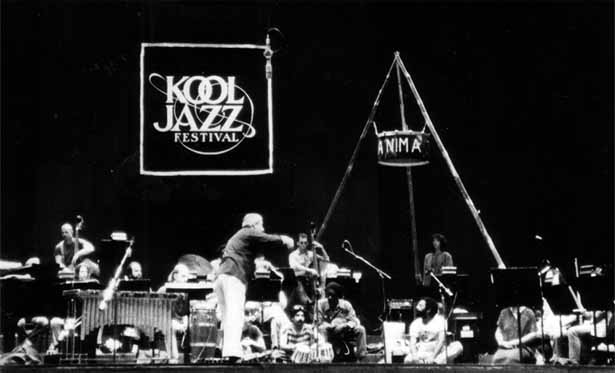
Paul and Limpe Fuchs and their two children, a friendly, amiable family from Germany, are visiting the United States and happened to stop in at Pick-Staiger concert hall Tuesday night. Nothing unusual except for what they did when they got there, which is very unusual.
What the Fuchs family does is perform mesmerizing music under the name Anima, and they have been doing it across Europe for the past fifteen years to a combination of critical acclaim and head scratching.
Anima uses a variety of homemade instruments combined with standard instruments to create a musical world of their own in which any method used to create sound is valid — a kind of intrafamily anarchy.
Paul Fuchs, Anima’s leader, is a sculptor by trade who makes what he calls sound sculptures — pieces of copper, bronze and wood that become unique musical instruments in his hands
On stage Tuesday night lie showed off a partial sampling of his collection including:
In addition to the Fuchs instruments, Anima uses tympani, cymbals, tube drums (similar to jazz drummer Billy Cobham’s Octobans), a foot zither, temple blocks, a drum kit (played by Paul and Limpe’s son Zoro Babel), violin and piano, plus occasional vocals by Limpe.
What type of sound is produced by such a combination? Without actually hearing a performance it is very difficult to describe, because "Anima music" (as the Fuchs distinguish their music from what they call “normal music”) defies categorization. At times their music reminds one of a variety of styles, from the improvisatory musings of Keith Jarrett to a Grateful Dead space jam, from Ornette Coleman’s harmolodics to a Stockhausen percussion performance.
“It’s not ‘new music’ and it’s not jazz; it’s Anima,” explains Paul. “We try to keep away from influence, from all musicians. We try all the time to forget records, to forget the things we’ve written, to forget other musicians. When we play we try to stay virgin. We try to find a way to make this special music because we think it’s very necessary to create music and not consume it.”
The beginnings of Anima go back to 1963 when Fuchs made his first klangskulkptur or sound sculpture, a Fuchs horn.
"I got sick of all those blasted sculptures standing in the corner," Paul said. "I couldn’t do anything with them. So I started to build the first sound sculpture out of bronze. I tried to build a sculpture I could use every day. After three years, I started to make music with limpe. Then I built others, and we appeared in public.
“The first time was in Munich in 1968. We played small places, then the next year in big ones. This was in the ’underground’ time and we had one really wild concert, a wild ’happening. We called it ’Underground Explosion’; it was very avant-garde. With this program we toured Germany, the first big tour we did.”
Since that time, Anima has performed in numerous situations throughout Europe and in America, including a 1971 European tour called “Through Europe at 20 kilometers an hour” which saw them go from city to city in a farm tractor that carried a stage and sheep in addition to the family.
They have played outdoor festivals and at open air markets, and when they were in British Columbia in 1981 they set up shop out in the woods and played with nature as their audience. More recently they’ve taught at the Creative Music Foundation in Woodstock, N.Y., but have had to limit their U.S. visits because of limited funding.
As a family situation, Anima is unique. Paul the sculptor and Limpe the music teacher (she is trained on violin, piano and percussion) join their 16-year-old son Zoro to create a music that, thanks partly to the original Fuchs instruments, could never be duplicated by others. Anima music can go anywhere; for any length of time, as the musicians determine the boundaries.
Limpe chafes at adapting this free-flowing style to commercial restrictions: “To play for a radio show, we have to watch how long (we play). This is not really Anima, because to find the end is a very important thing, and when it depends on ’Now it has to end’ . . . it’s possible but it’s not Anima.”
Their sound is paradoxical — at once disciplined and free, harsh and delicate. An ensemble of intricate polyphony whose individual members never sacrifice their individuality to the communal sound, yet one will drop out suddenly if he or she feels it’s necessary, anct just as suddenly join in as the mood strikes. More than the sum of its parts, Anima is a refreshing synthesis of all of music’s deepest, most fundamental elements.Paul Fuchs summarized: “From the basics to the top . . . always from the basics. This is creative music.”